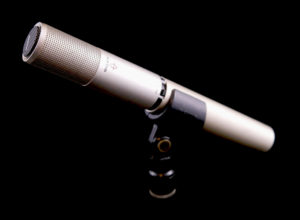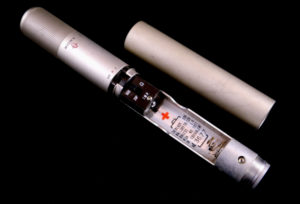
Sony ECM-22P Microphone
When I started in the recording business in 1973, my work was primarily live concert recording for schools and churches. My location setup was a Teac 7030 2-track reel-to-reel recorder, a Shure M-688 stereo mixer, and two Sony ECM-22P Electret condenser microphones.
Sony’s ECM series of electret microphones were a game-changing innovation in condenser microphones when they were first introduced in 1968. First of all, the electret capsule in the microphone did not require a separate bias voltage. Electret technology allowed a permanent electrical charge to be applied to either the diaphragm or the backplate of the microphone capsule, similar to the way a permanent magnet is magnetized, except in this case it is an electrical field rather than a magnetic field.
Elimination of this need for external bias meant that there was less circuitry inside the microphone and no external bias power supply was required. Phantom power had only made its way into microphone technology a few years prior, so most condenser microphones still had an external power supply.
The other innovation was the use of a JFET transistor amplifier for the electret capsule. Solid state circuitry was only introduced into condenser microphones a few years before this, so many condenser microphones still required heavy, bulky power supplies for their vacuum tube amplifiers. In fact, the Neumann U-87 solid state microphone was released in 1972.
So the ECM-22P was a real innovation and quite revolutionary. It brought the cost of a quality condenser microphone within reach of the small and home studio owner and was one of the products that helped fuel the home recording revolution. I paid about $100 each for the pair of microphones at that time.

Sony ECM-22P Microphone Internal View
This mike was powered by an Eveready 206 9V battery which was expensive and hard to find, or from phantom power. I didn’t have a phantom powered mixer at the time, and there were few, if any, available. If you forgot to turn the switch on the mike off, it was likely the battery would be drained the next time you needed to use it.
The circuitry in the microphone was very simple with a single JFET driving an output transformer with a switchable 600 or 250-ohm output. The power switch had three positions, Off, Music, and Voice. The voice position engaged a low-frequency roll off filter.
The ECM-22P is a cardioid microphone with a rated frequency response of 40-15,000 kHz. The signal-to-noise ratio was 66 dB, which is quite noisy by today’s standards, but a little better than the signal-to-noise of a reel-to-reel recorder running at 15 ips. with high-bias mastering tape. So the mikes performed well for me for some years.
I bought another pair of the microphones when I moved from my home studio into a commercial space in 1976. I still have all four of them, and they all still work even though I don’t use them anymore. I eventually replaced them in the early 1980’s with Shure SM-81 microphones which still get a lot of use today.
